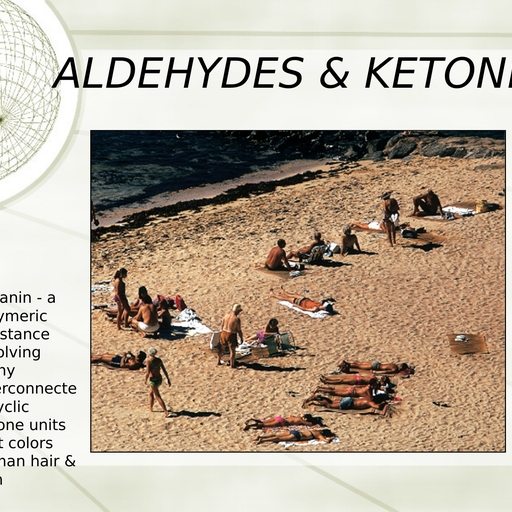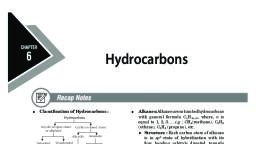Page 1 :
CHAPTER 13, HYDROCARBON, Hydrocarbons are composed of Carbon and hydrogen., The important fuels like Petrol, kerosene, coal gas, CNG, LPG etc. are all, hydrocarbons or their mixture., Sources:, Petroleum and natural gas are the major sources of aliphatic hydrocarbon while coal is an, important source of aromatic hydrocarbons. The oil trapped inside the rocks is known as, petroleum. PETRA – ROCK, OLEUM – OIL. The oil in the petroleum field is covered with, a gaseous mixture known as natural gas. The main constituents of the natural gas are, methane, ethane, propane and butane., , CLASSIFICATION OF HYDROCARBONS:, HYDROCARBON, , Acyclic or Aliphatic, ( Open chain), , Carbocyclic or Cyclic, , Alicyclic, Alkanes, , Alkenes, , Aromatic, , Alkyne, , Cycloalkanes Cycloalkenes, , Cycloalkynes, , Alkanes: Paraffins, General formula CnH2n+2, sp3 hybridisation, C–C bond length 1.15 4 A0, Chemically unreactive, Show chain, position and optical isomerism., Heptane has 9 isomer, Octane 18 and Decane 75., Nomenclature:, , 163
Page 6 :
CONFORMATIONAL ISOMERISM:, The different molecular arrangements arising as a result of rotation around carbon, carbon single bonds are called conformational isomers or rotational isomers and the, phenomenon is called conformational isomerism., Numerous possible arrangements of ethane are possible. Two extreme conformations, are known. These are eclipsed conformation and staggered conformation., SAWHORSE REPRESENTATION, H, , H, , H, H, , H, H, , H, , H, H, , H, , H, H, STAGGERED, , ECLIPSED, , NEWMAN PROJECTION, H, H, , H, H, , H, , H, H, H, , H, , H, H, , H, , STAGGERED, , SKEW, , ECLIPSED, 168
Page 13 :
Acidity of Alkynes- Terminal alkynes are acidic in nature., , Alkanes, alkenes and alkynes follow the following trend in their acidic, behaviour :, , AROMATIC HYDROCARBON, Aromatic compounds containing benzene ring are known as benzenoids and those, not containing a benzene ring are known as non-benzenoids., Structure of BenzeneKekulé structure, , Resonance and stability of benzene-Benzene is a hybrid of various resonating, structures., , The orbital overlapping picture benzene- All the six carbon atoms in benzene are, sp2 hybridized and these hybrid orbitals form sigma bonds., 175
Page 14 :
The unhybridised p orbital of carbon atoms are close enough to form a π bond by, lateral overlap., , 176
Page 15 :
The six π electrons are thus delocalised and can move freely about the six carbon, nuclei. The delocalised π electron cloud is attracted more strongly by the nuclei of, the carbon atoms than the electron cloud localized between two carbon atoms., Therefore, presence of delocalised π electrons in benzene makes it more stable ., Aromaticity:- The compounds that follow the following features are to be considered, aromatic., (i) Planarity, (ii) Complete delocalisation of the π electrons in the ring, (iii) Presence of (4n + 2) π electrons in the ring where n is an integer (n = 0, 1,, 2, . . .). This is often referred to as Hückel Rule., Preparation of Benzene:, (i) Cyclic polymerisation of ethyne:, (ii) Decarboxylation of aromatic acids:, , (iii) Reduction of phenol: Phenol is reduced to benzene by passing its vapours over, heated zinc dust, , Physical properties:, 1. Aromatic hydrocarbons are non- polar molecules and are usually colourless, liquids or solids with a characteristic aroma., 2. Aromatic hydrocarbons are immiscible with water but are readily miscible, with organic solvents., 3. They burn with sooty flame., Chemical properties, Arenes are characterised by electrophilic substitution reactions proceed via the, following three steps:, (a) Generation of the eletrophile, (b) Formation of carbocation intermediate, (c) Removal of proton from the carbocation intermediate, , 177
Page 18 :
due to resonance the electron density on o– and p– positions is greater than, that at the m-position. Hence, they are also o– and p– directing groups., CARCINOGENICITY AND TOXICITY-Benzene and polynuclear hydrocarbons, containing more than two benzene rings fused together are toxic and said to possess, cancer producing (carcinogenic) property., ONE MARK QUESTIONS, 1. What are hydrocarbons?, Ans. Compounds of hydrogen and carbon., 2. What is the general formula of alkanes?, Ans. CnH2n+2, 3. Write the general formula of alkenes., Ans. CnH2n, 4. What is the general formula of alkynes?, Ans. CnH2n-2, 5. Give the IUPAC name of lowest molecular weight alkane that contains a, quaternary carbon., Ans. 2,2dimethylpropane., 6. Arrange the following in the increasing order of C-C bond lengthC2H6 C2H4 C2H2, Ans. C2H2 < C2H4 < C2H6, 7. Out of ethylene and acetylene which is more acidic and why?, Ans. Acetylene, due to greater electonegativity of the sp hybrid carbon., 8. Name two reagents which can be used to distinguish between ethene and, ethyne., Ans.Tollen’s reagent and ammonical CuCl solution., 9. Arrange the following in order of decreasing reactivity towards alkanes., HCl, HBr, HI, HF, Ans.HI> HBr> HCl >HF, 10. How will you detect the presence of unsaturation in an organic compound?, Ans. Generally Unsaturated organic compound decolourise Bayer’s reagent, and Bromine water., 11. What is Grignard reagent?, Ans. Alkyl magnesium halides, TWO MARKS QUESTIONS, 1. Write the IUPAC names of the following-, , a., Ans. a .Pent-en-3-yne, , b., b. 2-methylphenol, 180
Page 19 :
2. Write chemical equations for combustion reaction of (i) Butane (ii) Toluene, Ans., , ., , (ii), Toluene, , 3. What are the necessary conditions for any system to be aromatic?, Ans. A compound is said to be aromatic if it satisfies the following three, conditions: (i) It should have a planar structure., (ii) The π–electrons of the compound are completely delocalized in the ring., (iii)The total number of π–electrons present in the ring should be equal to, (4n + 2), where n = 0, 1, 2 … etc. This is known as Huckel’s rule., 4. What effect does branching of an alkane chain has on its boiling point?, Ans. As branching increases, the surface area of the molecule decreases which, results in a small area of contact. As a result, the Van der Waals force also, decreases which can be overcome at a relatively lower temperature. Hence, the, boiling point of an alkane chain decreases with an increase in branching., 5. How would you convert the following compounds into benzene?, (i), Ethyne (ii) Ethene, , Ans. (i) Benzene from Ethyne:, (ii) Benzene from Ethene:, , 181
Page 20 :
6. Suggest the name of Lewis acids other than anhydrous aluminium chloride, which can be used during ethylation of benzene., Ans. anhydrous FeCl3, SnCl4, BF3 etc., 7. Write the name of all the possible isomers of C2H2Cl2 and indicate which of, them is non-polar., Ans.(i) cis-1,2-dichloroethene (ii) trans-1,2-dichloroethene, (iii) 1,1dichloroethene. trans-1,2-dichloroethene is non-polar., 8. Although benzene is highly unsaturated, it does not undergo addition reactions,, why?, Ans. Because of extra stability due to delocalization of π-electrons., 9. What are alkanes? Why are they called paraffins?, Ans. Those hydrocarbons which contain single bond between carbon- carbon, are called alkanes. They are called paraffins because they are very less, reactive (Latin- Parum= little, affins = affinity), 10. How can ethene be prepared from (i) ethanol (ii) ethyl bromide?, Ans. (i) Ethene from ethanol- by acidic dehydration of alcohols, , (ii), , Ethene from ethyl bromide- by dehydrohalogenation of ethyl bromide, CH3CH2Br + KOH (alc) → H2C = CH2 + KBr + H2O, , THREE MARKS QUESTIONS, 1. What is Wurtz reaction? How can it be used to prepare butane?, Ans- When alkyl halides is treated with metallic Na in presence of dry ether,, alkanes are formed. This reaction is called Wurtz reaction., Butane is prepared by the reaction of bromoethane with metallic Na in, presence of dry ether, , 2. An alkene ‘A’ contains three C – C, eight C – H σ bonds and one C – C π, bond. ‘A’ on ozonolysis gives two moles of an aldehyde of molar mass 44 u., Deduce IUPAC name of ‘A’., Ans.. The formation of two moles of an aldehyde indicates the presence of, identical structural units on both sides of the double bond containing carbon, atoms. Hence, the structure of ‘A’ can be represented as:, XC = CX, There are eight C–H σ bonds. Hence, there are 8 hydrogen atoms in ‘A’. Also,, there are three C–C bonds. Hence, there are four carbon atoms present in the, structure of ‘A’., 182
Page 21 :
Combining the inferences, the structure of ‘A’ can be represented as:, , the IUPAC name of ‘A’ is But-2-ene., Ozonolysis of ‘A’ takes place as:, , The final product is ethanal with molecular mass, , 3. In the alkane H3C – CH2 – C(CH3)2 – CH2 – CH(CH3)2, identify 1°,2°,3°, carbon atoms and give the number of H atoms bonded to each one of these., Ans., , The given structure has five 1° carbon atoms and fifteen hydrogen atoms, attached to it., The given structure has two 2° carbon atoms and four hydrogen atoms, attached to it., The given structure has one 3° carbon atom and only one hydrogen atom is, attached to it, FIVE MARKS QUESTIONS, 4. Addition of HBr to propene yields 2-bromopropane, while in the presence of, benzoyl peroxide, the same reaction yields 1-bromopropane. Explain and give, mechanism, Ans. Addition of HBr to propene is an example of an electrophilic substitution, reaction., 183
Page 22 :
Hydrogen bromide provides an electrophile, H+. This electrophile attacks the, double bond to form 1° and 2° carbocations as shown:, , Secondary carbocations are more stable than primary carbocations. Hence, the, former predominates since it will form at a faster rate. Thus, in the next step,, Br– attacks the carbocation to form 2 – bromopropane as the major product., , This reaction follows Markovnikov’s rule, In the presence of benzoyl peroxide, an addition reaction takes place anti to, Markovnikov’s rule. The reaction follows a free radical chain mechanism as:, , 184
Page 23 :
Secondary free radicals are more stable than primary radicals. Hence, the, former predominates since it forms at a faster rate. Thus, 1 – bromopropane is, obtained as the major product., , HOTS QUESTIONS, 1. How will you demonstrate that double bonds of benzene are somewhat, different from that of olefins?, Ans.The double bonds of olefins decolourize bromine water and discharge the, pink colour of Bayer’s reagent while those of benzene not, 2. How will you separate propene from propyne?, Ans. By passing the mixture through ammonical silver nitrate solution when, propyne reacts while propene passes over., 3. Write is the structure of the alkene which on reductive ozonolysis gives, butanone and ethanol,, Ans.-CH3CH2C(CH3)=CHCH3, , 185




































































